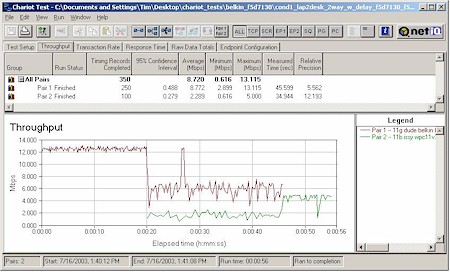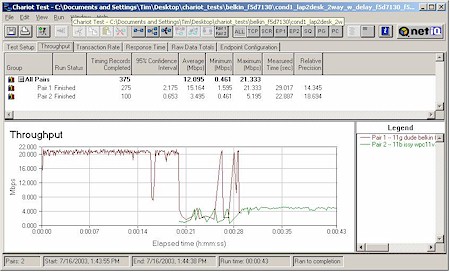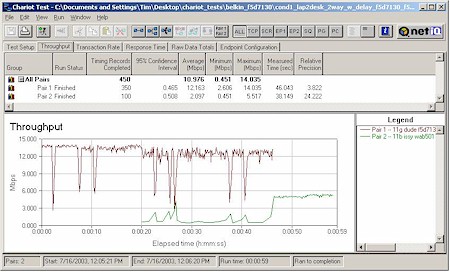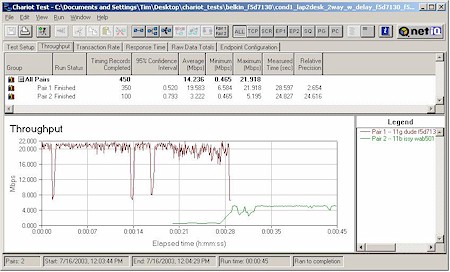802.11b Interoperability
My last round of tests checked the handling of simultaneous 802.11b and 11g traffic. Again using Chariot, I set up a test using two client pairs. The reference 802.11g test pair for each test was a WinXP Home Dell Laptop with Belkin F5D7010 Cardbus card to Win98SE Ethernet client. The second pair used a WinXP Home Compaq Presario 1650 Laptop with various 802.11b cards to a different Win98SE Ethernet client. I tested the following cards:
- Linksys WPC11 v3 (Intersil PRISM III based card)
- NETGEAR WAB501 (Atheros 5001X dual-band chipset)
In each test, I started the Belkin card first, then kicked in the 802.11b card. Both cards then run simultaneously for awhile, with the Belkin card stopping first to let the 11b card finish by itself. As Figures 10 -13 show results with 11b protection enabled and disabled.

Figure 10: Two pair test, 11b protection enabled - Linksys WPC11 v3
(click on the image for a full-sized view)

Figure 11: Two pair test, 11b protection disabled - Linksys WPC11 v3
(click on the image for a full-sized view)
The results clearly show better "cooperation" between the 11g and 11b stations with protection enabled - as I'd expect - but with significant top-speed reduction for the 11g client with the 11b client associated to the same AP but idle. It also shows the price that might be paid for disabling protection when 11b clients are around, with the 11g station taking a much harder throughput hit when the 11b station starts transmitting.
By comparing the start of Figure 11's 11g plot with the top plot in Figure 9, you can see that even with protection disabled, the 11g client experiences a slight throughput reduction (about 1Mbps) when the 11b client is associated by idle. This says to me that even when the "official" 11b protection mechanism is shut off, Broadcom still has some sort of 11b detection mechanism running.

Figure 12: Two pair test, 11b protection enabled - NETGEAR WAB501
(click on the image for a full-sized view)

Figure 13: Two pair test, 11b protection disabled - NETGEAR WAB501
(click on the image for a full-sized view)
I included the WAB501 results in Figures 12 and 13 to show the variation in mixed WLAN performance that apparently still exists even in 11g spec-compliant products. The difference in interaction between the Broadcom, Intersil, and Atheros clients is striking, and probably why all vendors are pushing forward with their mixed-mode throughput enhancement technologies.
802.11g Wireless Performance Test Results
| Test Conditions
| Firmware/Driver Versions AP f/w: | ||||
|---|---|---|---|---|---|
| Test Description | SNR (dB) | Transfer Rate (Mbps) | Response Time (msec) | UDP stream | |
| Throughput (kbps) | Lost data (%) | ||||
| Client to AP - Condition 1 | 55 | 21.3 [No WEP] 22.1 [w/ WEP] | 1 (avg) 2 (max) | 499 | 0 |
| Client to AP - Condition 2 | 23 | 22.4 | 1 (avg) 2 (max) | 499 | 0 |
| Client to AP - Condition 3 | 10 | 15.8 | 1 (avg) 3 (max) | 499 | 0 |
| Client to AP - Condition 4 | 4 | 5.5 | 1 (avg) 2 (max) | 491 | 0 |